-

2022-05-02
This is a tweet from Anna Akana regarding the leaked opinion draft from the Supreme Court, which would overturn Roe v. Wade. Here, she is criticizing people who use "my body, my choice" in regards to masks, but don't allow it for when it comes to women's reproductive health.
-
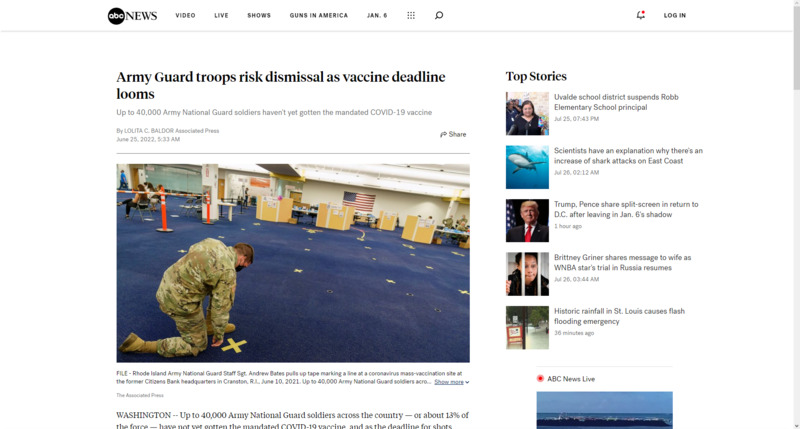
2022-06-25
This is a news story from ABC news by Lolita C. Baldor. Up to 40,000 National Guard soldiers, which consists of roughly 13% of the force, have not yet received the mandated COVID vaccine. Soldiers have until Thursday to get the vaccine. Out of all military branches, the National Guard was given the largest window to fulfill that requirement.
-
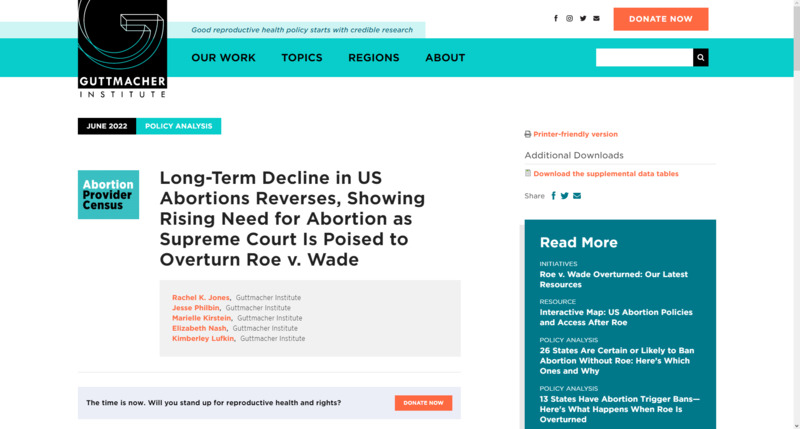
2022-06-15
This is a news story from The Guttmacher Institute. This article was written before the official Supreme Court decision was released on abortion. The article states that the 30 year decline in abortions has picked up with the threat of Roe v. Wade getting overturned. At the time this article is being entered in, Roe has been officially overturned by the Supreme Court. What is more interesting to me are the numbers given on abortions in 2020, when COVID was at its peak.
In 2020, there was 930,160 total abortions, which was an 8% increase from 862,320 abortions in 2017. In 2020, about 1 in 5 pregnancies ended in abortion. The increase in abortions was marked in an overall 6% decrease in births between 2017 and 2020.
The article does not discuss the social reasons why more abortions were happening in 2020 compared to other years, but in my own opinion, people's fears of hospitals being too full and the financial strain of lockdowns would have made it difficult to want to carry a baby to term. At the time, people were unsure of how long lockdowns and restrictions would last, so getting the pregnancy care needed to prevent issues giving birth would have been harder to come by.
-
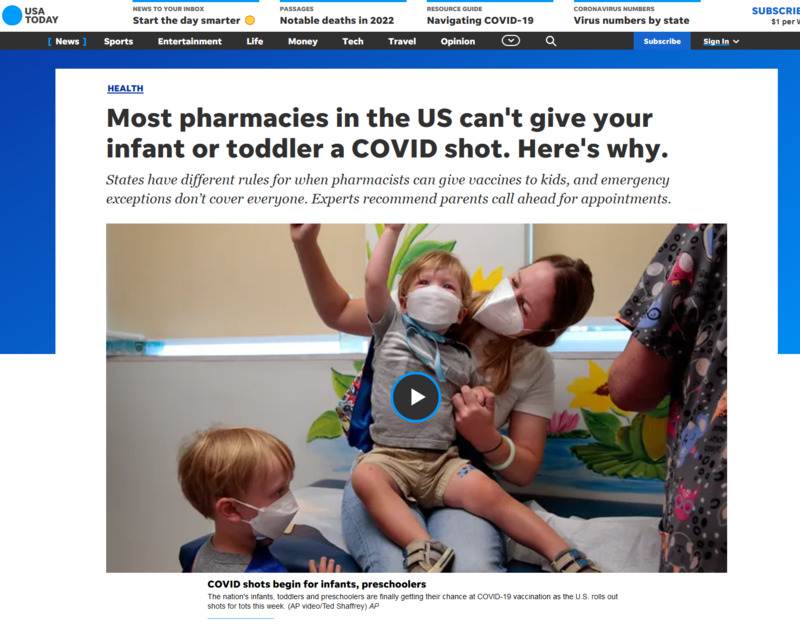
2022-06-23
This is a news story from USA Today by Adrianna Rodriguez. Most US pharmacies don't allow their technicians to administer the vaccine to children under five. The age in which the vaccines can be ministered to younger kids varies, with most putting a minimum of five or above. A lot of the reason administering vaccines has been restricted, according to the article, is because not enough pharmacists are trained to give shots to children that young. The overall target is smaller, and the needle even shorter, in addition to needing to calm and anxious child. This makes people hesitant to give young kids the COVID vaccine. It is recommended that if you cannot find a pharmacy that will give the shot to very young kids that you ask your pediatrician for a one-on-one appointment for the vaccine.
-
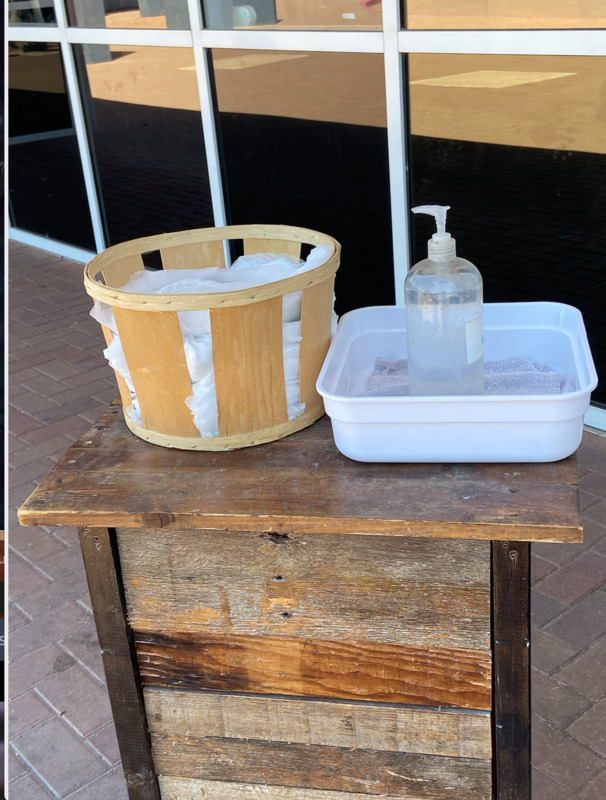
2022-06-22
This was one thing I saw at Feed My Starving Children while volunteering there. By rules on food handling from the FDA, everyone is supposed to wear hair nets while working with the food. However, the hand sanitizer was new to me. The check-in wasn't through a computer like it was before, when I volunteered years prior to COVID. People had to go up and say the group they were with, and the check-in was next to the hand sanitizer and hair net station. Due to the facility handling food, hand washing stations were also in the building, but many of these precautions aren't COVID related so much as abiding by FDA guidelines.
-
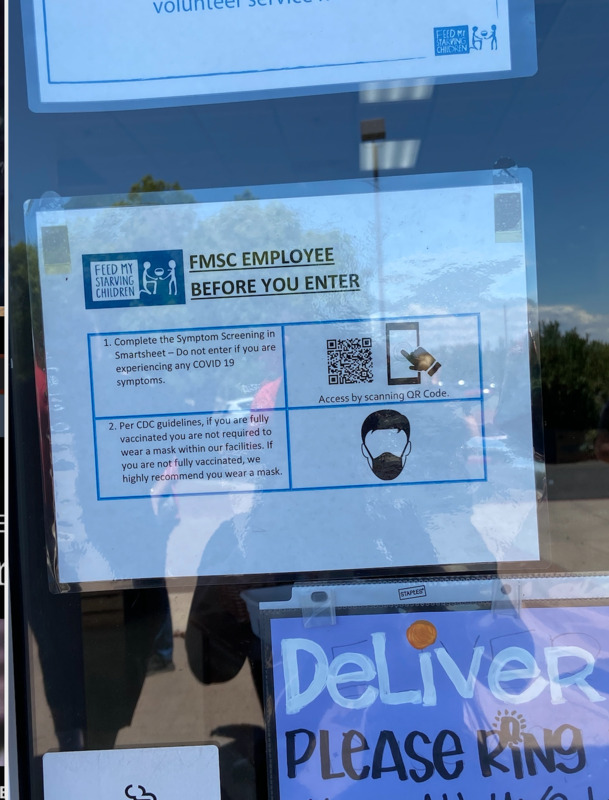
2022-06-22
This was a sign I saw on June 22, 2022 while volunteering at Feed My Starving Children. Upon entering, I was worried that I would need a mask in order to participate. It turns out, masks were not mandatory. Some people that did come at the session I did were wearing masks, but a good majority of people were not. One of the coordinators said that now they are able to host up to 125 people at a time for a session. At the very beginning when things were just opening up again, that number was at 10. The coordinator said that if things go to plan, FMSC should be able to host 145 people at a time, increasing the amount of pallets that can be shipped across the world to help children in need
-
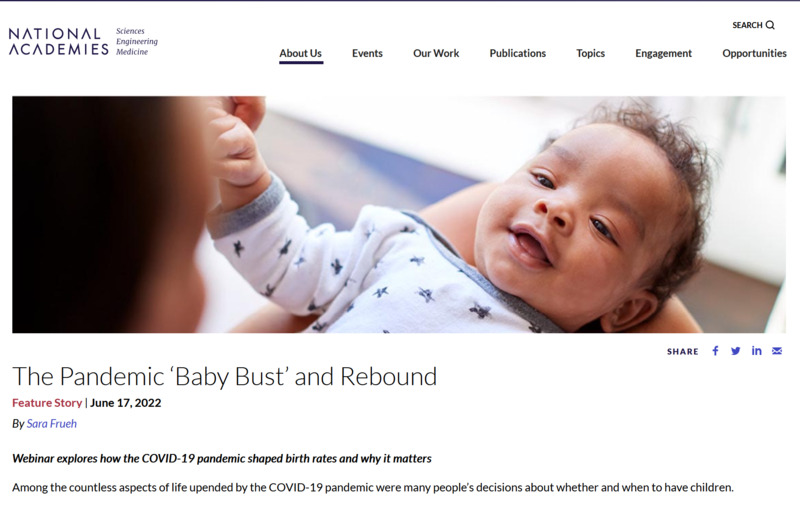
2022-06-17
This is a news story from National Academics by Sara Frueh. It goes over the data of births throughout the pandemic. Melissa Kearney, a professor of economics at the University of Maryland, says that there was this idea at the beginning of the pandemic that it would lead to a baby boom with people being forced to stay home, but it did not.
She adds that closed or limited facilities at the height of the pandemic maybe impacted some people. To support the claim, she brings up the pandemic from 1918-1919 and how that also led to decreased birth rates.
An analysis of the data from Kearney states there were 62,000 fewer conceptions in the years from 2020-2021. There was a small increase in conception rates in the summer of 2020, but fell into decline again soon afterwards.
The overall trend that Kearney sees with the birth and conception rates is that is has been a steady decline after COVID.
-
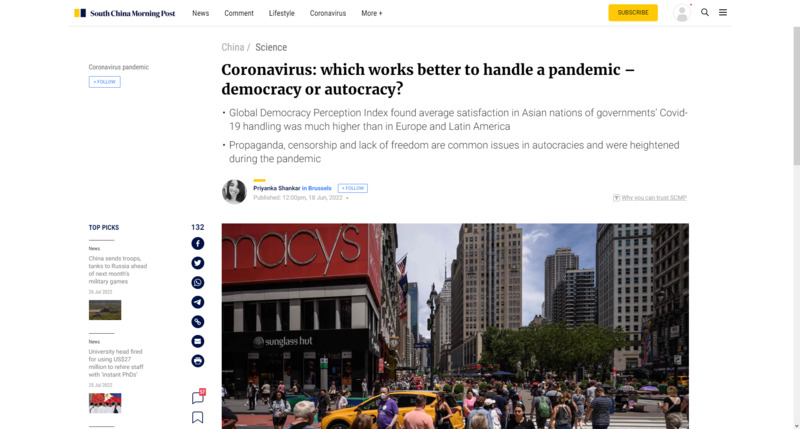
2022-06-18
This is a news story from the South China Morning Post by Priyanka Shankar. This article is discussing the difference in responses based on forms of government. When it came to handling the pandemic, people from Asian countries where restrictions were much tougher rated a higher rate of satisfaction in government response compared to Latin America and Europe. This was taken from the Democracy Perception Index. According to researcher Fredrick DeVeaux, a leader in conducting this survey, the tight restrictions common in Asian countries are generally accepted because it gets associated with low death rates. The survey does make mention that in countries such as Iran and China, they hid data about the virus from their citizens, affecting their overall response to changes in lockdowns. However, Singapore is also authoritarian, and the prime minister has made an effort to create transparency in what is occurring, so items get hoarded less. Overall, the article claims that the mass mobilization of people and goods under authoritarian regimes fares better than democracies do at creating an effective COVID response.
-
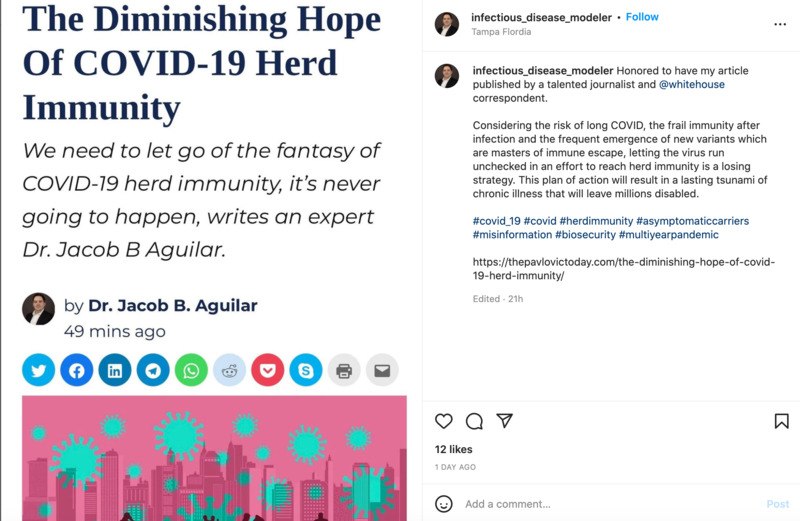
2022-06-16
This is an Instagram post from infectious_disease_modeler (Dr. Jacob B. Aguilar).He wrote an article about how herd immunity doesn't work with COVID as well as it could due to new variants that keep on happening. He says that if vaccines had a 100% effectiveness rates across all situations, this would not really be an issue. Since the vaccines are not entirely effective, the solution, Dr. Aguilar proposes that the way to help mitigate the issue is mass regular testing to slow the spread of new variants.
-
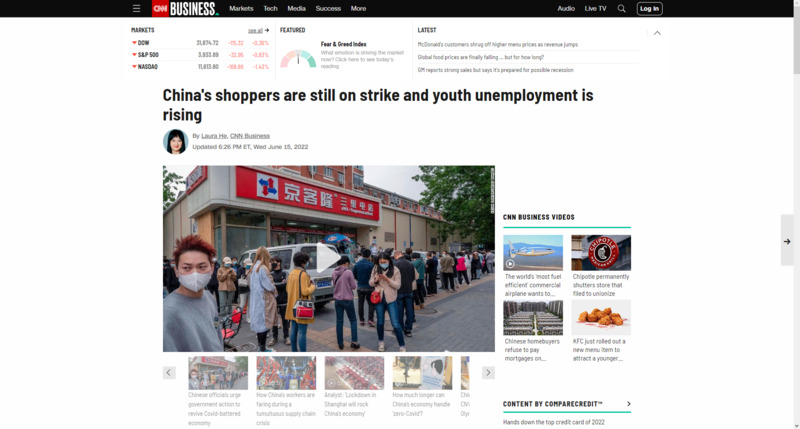
2022-06-15
This is a news story from CNN by Laura He. This article is on the economic impact of China's zero COVID policy.
Retail sales fell 6.7% in May according to China's National Bureau of Statistics. It is slightly lower than the 11. 1% drop in sales from April. Customer spending has fallen in about every category except for food, drink, and petroleum.
Youth unemployment is rising in China, as places that would hire young workers were forced to shutdown with lockdowns. The youth unemployment rate rose 18.4% between the 16-24 range in China.
-
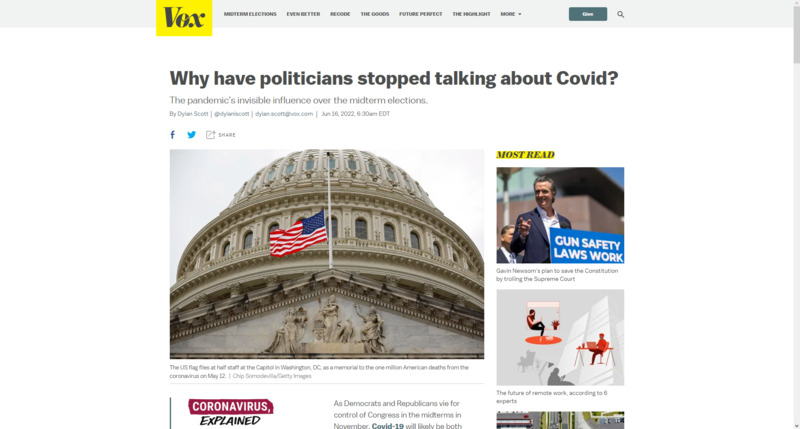
2022-06-16
This is a text story from Vox by Dylan Scott. The article claims that COVID helped sink President Donald Trump's re-election campaign, yet despite this, it is not being focused on by either party. Though, this author believes the Democrat response hasn't been much better, with people not really touting President Joe Biden's vaccine rollout and other initiatives.
The author links the reason for inflation being COVID interrupting supply lines, which is on people's minds for this midterm election. According to Gallup polling, COVID has lost importance in many people's minds, with it falling behind Russia and gas prices.
On the Republican side of things, COVID is rarely mentioned, and if it is, it is in a negative light. Scott says that candidates favored by Donald Trump have gone against his ideas, with them being more skeptical of vaccines, and some refusing to get the vaccine at all. COVID is being tied to an anti-establishment attitude that has been rising within the Republican party.
As for my own opinion on this piece, I believe that is does bring up an interesting point with linking COVID to current inflation. I do agree that COVID has impacted the economy for the worst with supply chains being more limited and rising spending of the federal government to counter it, but I do not think it can explain everything. Federal spending in general has been on an increase, which is driving up the cost of items, and not all that spending is COVID related. In addition to that, the shutdown of important pipelines has made reliance on foreign oil more of a necessity, which then drives up gas prices. These types of decisions can't all be traced back to COVID. So while I do think COVID has impacted the economy, I do not think it explains nearly all the economic issues the United States is facing.
-
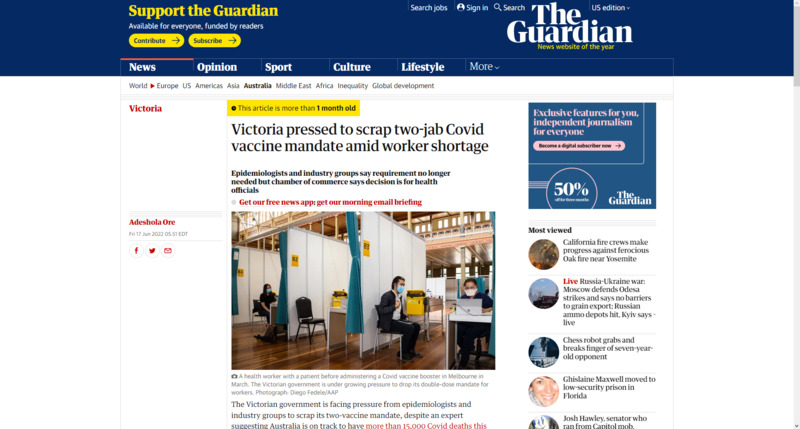
2022-06-17
This is a news story from The Guardian by Adeshola Ore. The Victorian government has been pressed to stop the two-jab vaccine mandate due to a worker shortage.
"While some industry groups have called for the two-dose mandate to be abolished to help ease the skilled workers shortage, the Victorian Chamber of Commerce and Industry (VCCI) said the decision was up to health officials."
"Almost 95% of Victorians aged over 12 have received two doses of a Covid vaccine."
-

2022-06-17
This is an Instagram post by ntsnoticiaspatz. It is saying that if you have not, you should register your kid to receive their vaccine. This is being promoted by the Mexican government.
-
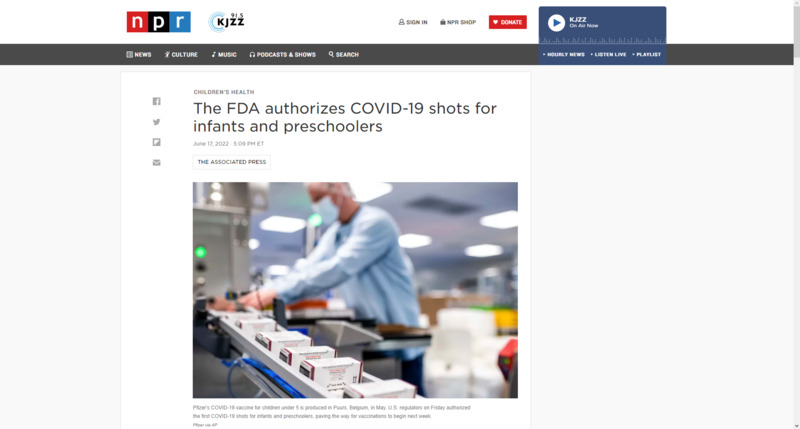
2022-06-17
This is a news story from NPR by The Associated Press. The United States has authorized the use of vaccines for infants and preschoolers. The Center for Disease Control and Prevention (CDC) is debating how the vaccines are to be administered. The article says that studies support giving these age groups the vaccines, as they are said to be effective and have minor side-effects.
-
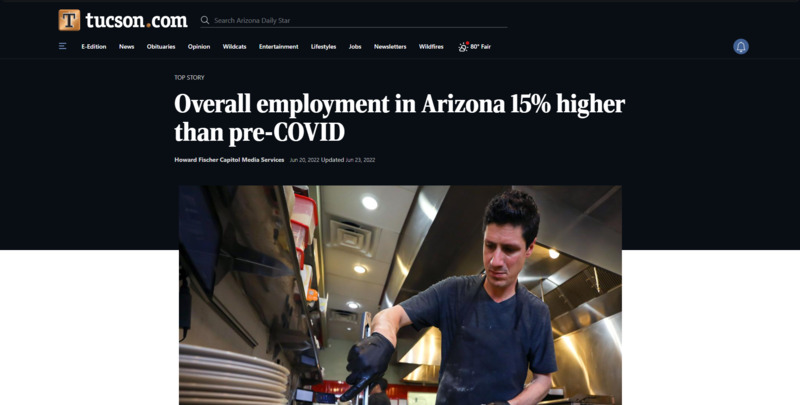
2022-06-16
This is a news story from Tuscon.com. Overall, employment has risen by 15% compared to pre-COVID numbers. Bars, restaurants, and hotels have increased employment by 10.6% since last year. Permits issued for single and multi-family homes are down by about 16% compared to last year. There is also a 32.6% price increase on energy prices, being driven by rising gasoline prices. Overall, this article shows economic trends in Arizona and how COVID has impacted various industries and consumer trends.
-
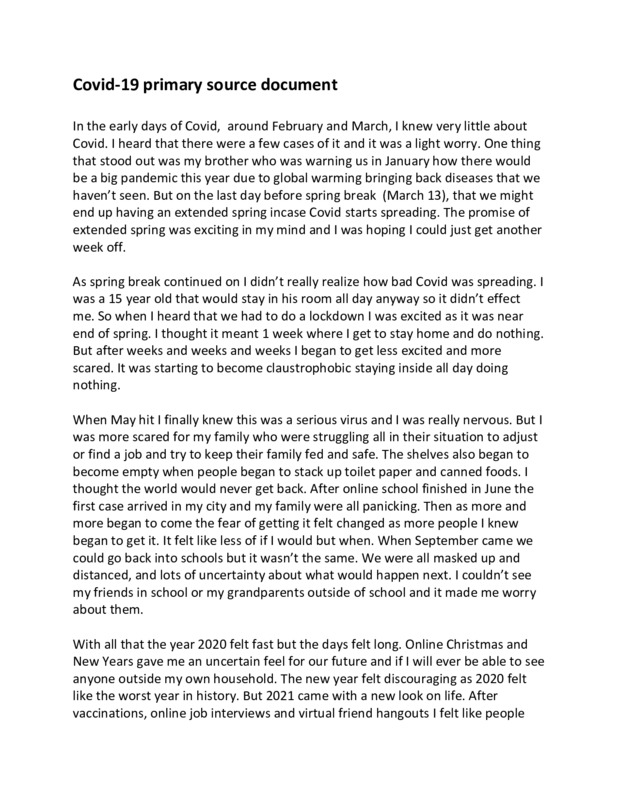
2022-06-16
Wanted to share how pandemic effected myself and my family
-
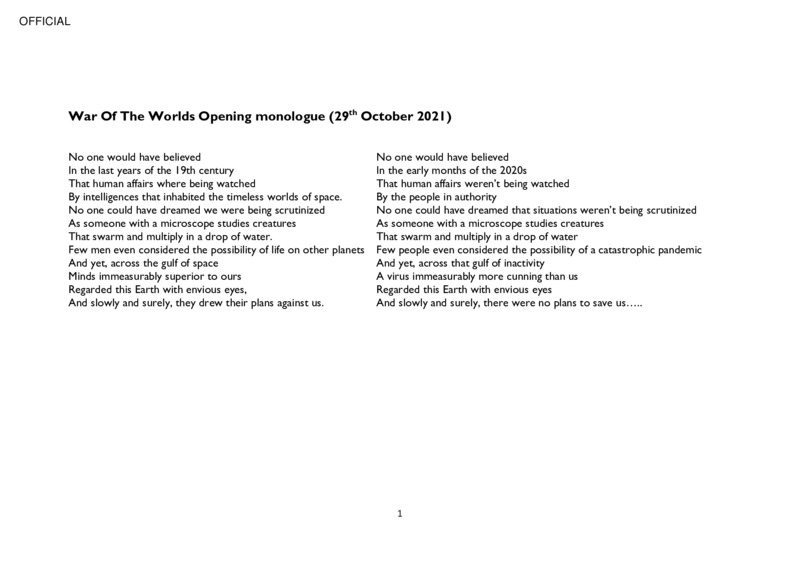
0031-03-22
For about 18 months during the main phase of the pandemic, I sent a daily covid (numbers and rates) tracker to a large number of colleagues in the Health and Social Care community in Plymouth. From October 2021 to March 2022, on each Friday I also included, with the covid tracker, a reworked pop song with Covid-related lyrics. It was a bit of fun, but people loved it and some Teams actually had a sing along to the new release each Friday. Depending on your age, you may know some of them. If nothing else, it made people look at the tracker.
-
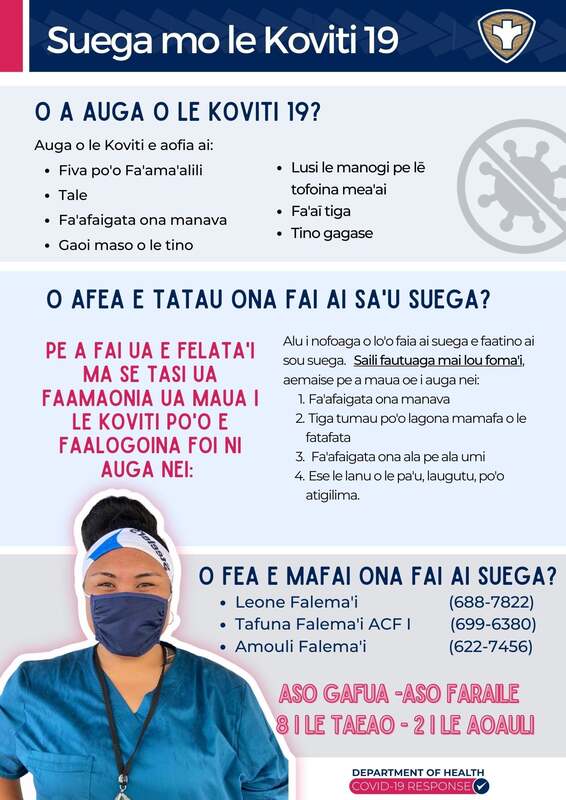
2022-02
The American Samoa Department of Health released this flyer in both English and Samoan languages for the public so they would know what time and day COVID testing sites are open, where they are located, and the number to call for each site if they need further information. Not only was this released online but placed in every store of the island.
-
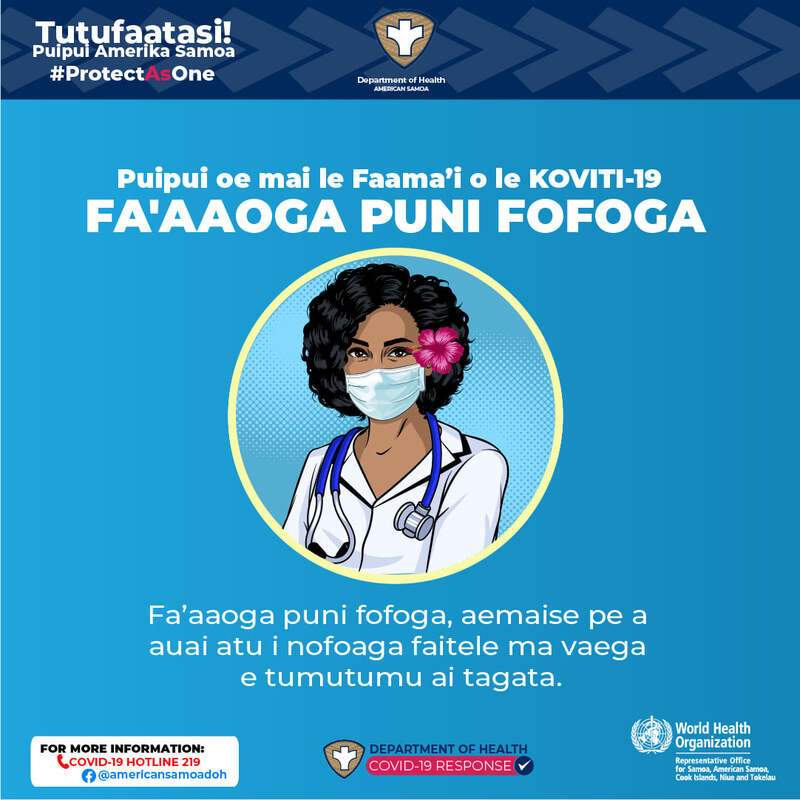
2022-02
With the rise of covid cases in American Samoa at the beginning of this year in February, the Department of American Samoa Health Department partnered up with the American Samoa government to make sure that the people of American Samoa are well aware of what to do to combat COVID. It is one of the many flyers and ads released by the ASDOH for the public of American Samoa. They are released in both the English and Samoan languages. This flyer is for people to wear a mask and in the Samoan language, fa'aaoga puni fofoga.
-

2022-06-14
This biography was created out of a self-directed project from the HST580 class. This biography will be linked to the submissions of the person mentioned in the document and title.
-

2022-06-14
This biography was created out of a self-directed project from the HST580 class. This biography will be linked to the submissions of the person mentioned in the document and title.
-

2022-06-14
This biography was created out of a self-directed project from the HST580 class. This biography will be linked to the submissions of the person mentioned in the document and title.
-

-2020-09-29
I have come to this platform as the stay-at-home mom of 2 adorable little girls, Emily 8 and Sara 11, who are simply the loves of my life, during the gut-wrenching time, last year, of the Coronavirus Pandemic! I also teach Part-time at Concordia University in the Department of Women's Studies and Journalism! :)
I could never have done this without the genuine love and kind-support of my loving husband Dennis, throughout our 43 years together! :)
-
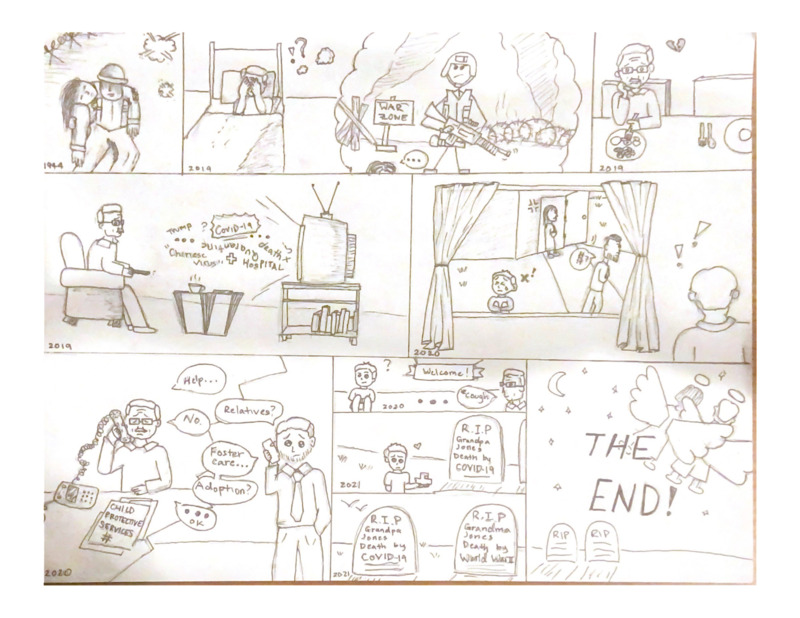
2022-06-13
I wrote this story about an elderly man who lost his wife in war and suffers from PTSD. He then hears then news about Covid-19 and becomes more isolated because his family is worried about giving him Covid since he is more susceptible to dying. However, as he is getting lonely he realizes his neighbors are abusing their son, so he decides to adopt the little boy. This is to show how domestic abuse became worse with Covid-19 and how some neighbors were able to connect more than before. Finally he catches Covid and passes away, leaving the boy alone again. However, it ends with the elderly man and his wife as angels together. The objective is to show that death is inevitable, with or without Covid-19, but Covid-19 has made many people's lives a lot harder with the added struggle of financial burden, loneliness, and family struggles.
-
2021-04-12
So one of my roommates got covid and because of that we had to self isolate ourselves in our rooms because we found out a couple days after he came back without taking a covid test to see if he had it before coming back. With that being said it was just very difficult to process and go through because there was 4 of us and only one could come out at a time making it very hard for us since we loved to communicate and talk to each other while watching shows in the living room yet now we had to just lock ourselves in our rooms not being able to see each other until my roommate was cleared. It is just hard to adjust right away to being locked in a room for weeks on end and because of it many can really get depressed and just feel awful at times. I wanted to highlight this because of how much of an impact just getting this virus has because some don't believe how bad it is but by now everyone should have realized how bad this pandemic really is for others that have it way worse.
-
2020-03-19
So this was the beginning of lockdown for covid-19 when it first started to get out of hand, I was trying to start my first year at my new college DePaul University. Yet it was going to be online for the first year and that is when it started to get rough from all the work I had to get done with little to no help at all from professors. They weren't opposed to helping it was just the fact that we could only find them in office hours and after class online and most of the times it was software problems that would take so long to be fixed to where it would take almost a couple of weeks to fix. When if it wasn't for covid I would be able to go in and fix it asap. It's just that the reason for this is because Covid can really affect ones learning progress and if it's something tech related it really can cause a delay for many not just students but office workers and professors etc.
-

2022-06-10
This is an article from NHK World-Japan.
There have been more COVID-19 cases reported in Tokyo, Japan. However, the article reports that the cases have been in decline despite these new 1,600 cases. The Japan Times website, they have a timeline that discusses the same 1,600 new cases, but also shows an Outbreak map of Japan's current cases, deaths, testing, and other things. This is a reminder that Japan is still struggling with the virus, but there is some hope with the cases decreasing weekly.
-
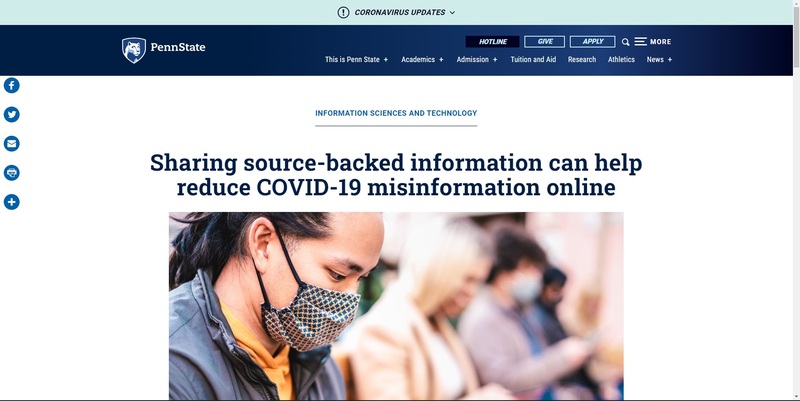
2022-06-09
This is a news story from Penn State University by Jessica Hallman. A recent study has shown that user corrections given back and forth on social media has helped reduce the spread of misinformation. Through sharing source-backed information, people were able to pick out fake news easier.
-
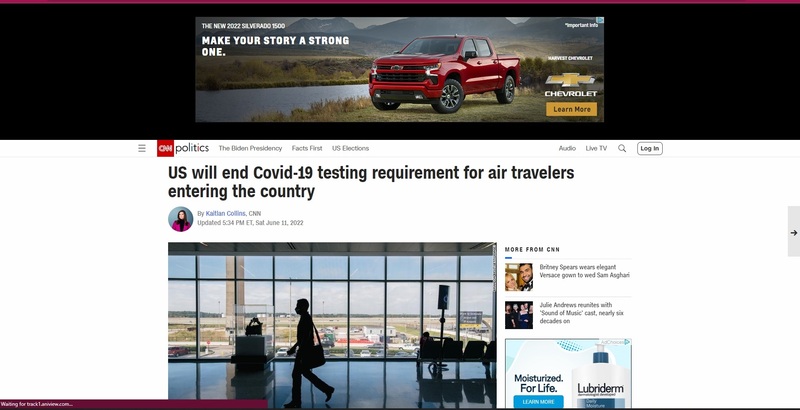
2022-06-11
This is a news story from CNN by Kaitlan Collins. The CDC is expected to lift the requirement for air travelers to test negative for COVID before entering the US. The travel industry has been lobbying the CDC for months regarding this issue after it was no longer determined that the restrictions are no longer "based on the science and data." However, just because it is getting lifted now, the CDC does have the power to reinstate this restriction if a new variant develops and causes concern.
-

2022-06-11
This is a news story from Healio by Michael Monostra. During the COVID pandemic, adolescents are eating less processed food.
"In an interim analysis of the Processed Intake Evaluation (PIE) study of 452 adolescents and young adults presented at ENDO 2022, participants reported eating less ultra-processed food during the first 2 years of the pandemic in 2020 and 2021 compared with prior to 2020. Ultra-processed food consumption dropped further in 2022 when COVID-19 restrictions eased."
-
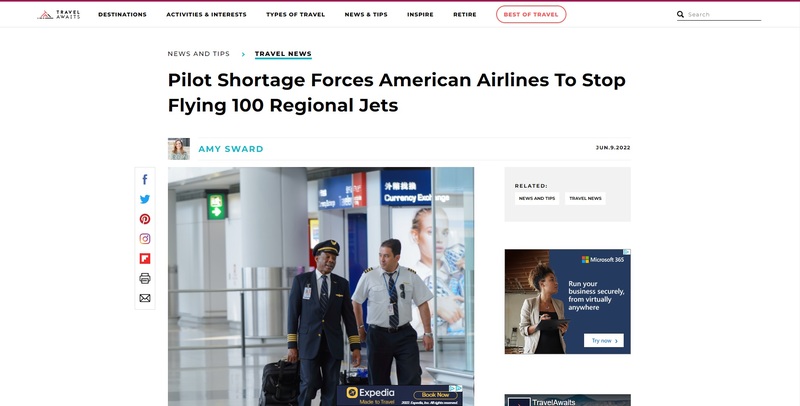
2022-06-09
This is a news story from Travel Awaits by Amy Sward. Due to a pilot shortage, nearly 100 planes are sitting idle because there are not enough people to fly them. Part of the reason for this pilot shortage is because of COVID. It is due to both buyouts and some pilots being forced into retirement due to age requirements. The shortage of pilots has created hiring sprees where companies like American Airlines are offering better pay and work schedules to lure people into flying for them. American Airlines plans to hire 2,000 pilots in 2022.
-
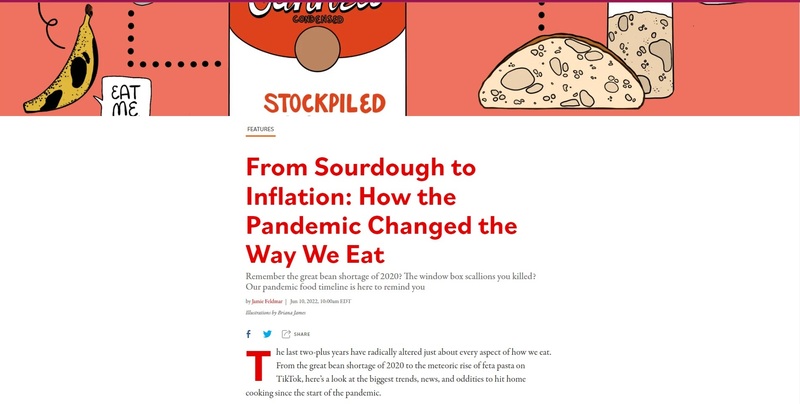
2022-06-10
This is a news story from Eater by Jamie Feldmar. This chronicles the changing food habits of people throughout the pandemic. In 2020, there was a wave of panic buying for things like flour, canned soups, and frozen vegetables. The use of grocery store delivery apps also increased that year. Instacart, a grocery delivery app, saw a 229% sales increase.
With the panic buying came people looking for ways to use up things like canned goods and dried pasta. Things like sheet pan dinners, salads, and other easy meals became sought after in that time.
Another change that occurred was people trying food trends popular during the pandemic. Things such as sourdough and whipped coffee were major food trends of that time.
Meal kit delivery rose during the pandemic. Blue Apron had subscriptions to their food service skyrocket. Hello Fresh did as well, and was forced to close down temporarily to hire 3,000 extra workers to tackle the rising demand.
In 2021, other food trends occurred while many restaurants and other dining establishments could not operate at full capacity. Things like espresso martinis and the dalgona candy, and candy made popular by the TV show Squid Game, were just some of those food trends.
The food trends were not without labor issues though. In October 2021, Kellogg's workers went on strike, which affected the supply chains of that brand.
Supply chain issues have become an ongoing problem since the beginning of the pandemic. In February 2022, the US temporarily shut down avocado imports from Mexico, making the food more expensive.
With supply chain issues comes rising inflation. According to the USDA, food prices in 2022 were expected to rise between 6.5% to 7.5% increases. The Russian war with Ukraine cited as one of those causes.
May 2022 saw a baby formula shortage, where 40% of baby formula was out of stock.
Today, the USDA is looking to learn from the pandemic and the food issues that are occurring. One way they are doing this is through "a framework to transform the food system," which has the focus on building a more resilient supply chain while providing for rural and underserved communities.
My own prediction is that the supply chain issues will mean more local food and less imported food overall in the United States. This means opening more food processing plants and increasing work domestically within the food industry to meet demands. The global food system is very fragile to things like pandemics and war. If food prices are to ever get lowered as well, it is important that more food gets produced and used locally. It would have the added benefit of being more environmentally friendly too, as the food would not have to be shipped as far away to where it gets used.
-
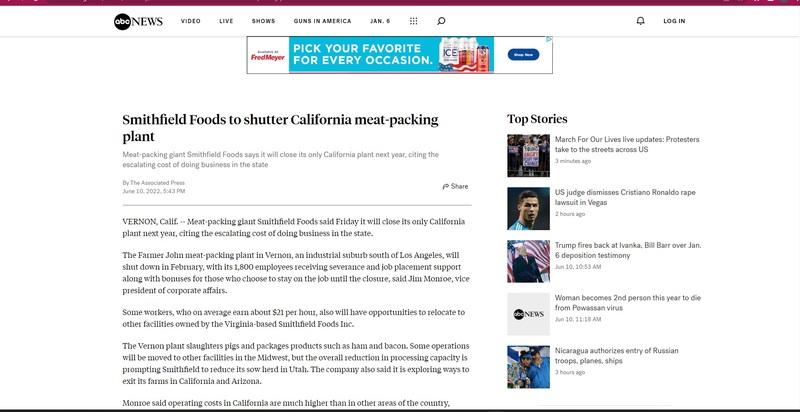
2022-06-10
This is a news story from ABC News by The Associated Press. The shutdown of the Smithfield Foods plant in California is happening in part due to COVID. Some 300 employees were exposed to the virus in 2020, which created labor issues. Due to the exposure, California's Division of Occupational Safety and Health fined the company $60,000.
-
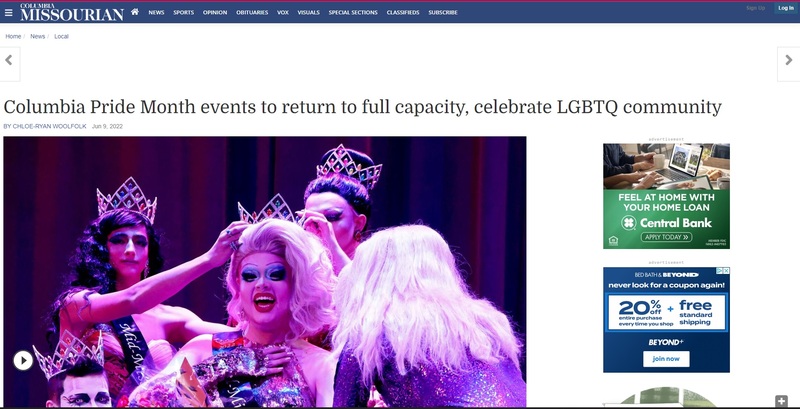
2022-06-09
This is a news story from Columbia Missourian by Chloe-Ryan Woolfolk. After two years of either cancellations or limited capacities, Pride Month events in Columbia will be returning to full capacity. Listed in the article are local events that people can attend now, with lists of fees and general details.
-
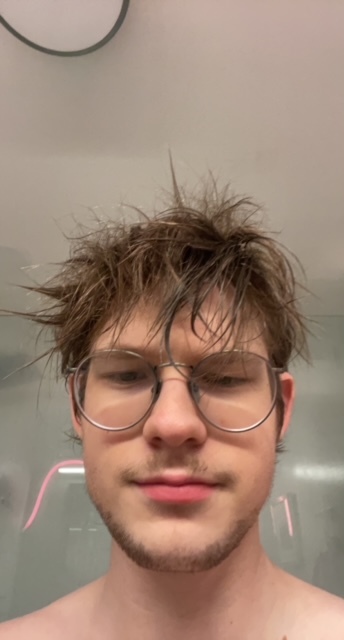
2022-06-11
I am an anxious person. Before covid it took all my energy to get up in the morning, put on decent clothes, go to school, meet with friends, go to restaurants. The lockdown was the best thing that ever happened to me. My best buddy moved in with me and my family, my classes went online, I slept more, I gamed all the time, we got takeout. Now I'm being invited places. I have to reinsert. I miss covid.
-
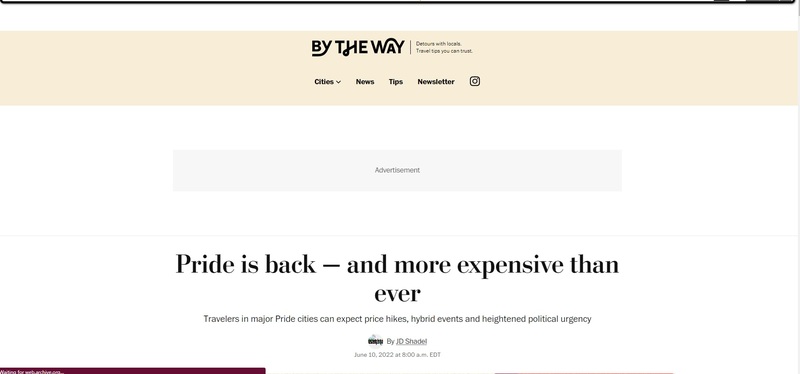
2022-06-10
This is a news story from The Washington Post by JD Shadel. Due to the last two years of Pride Month remaining virtual due to COVID, some changes have been made along with it. Included in the changes since COVID are leadership ones in Philadelphia and London after allegations of their Pride leadership having racism and transphobia.
The rising inflation has made it so summer travel is more expensive than before. Things like hotels, plane rides, and other modes of transportation cost more than they did before COVID.
One change that has been brought about because of COVID is the rise of virtual events. Groups like NYC Pride, Capital Pride and Pride Amsterdam will have online streaming available. The NYC Pride March and the LA Pride March will be available on Hulu.
Another debate that has changed since COVID are questions about "pinkwashing" in which a company will recognize Pride for profit, while not donating to any LGBTQ organizations. Some of the corporations in the past that have used Pride merchandise to sell things during Pride month while contributing to anti-LGBTQ organizations have been heavily criticized recently.
Overall, COVID has contributed to changes in how Pride is celebrated.
-
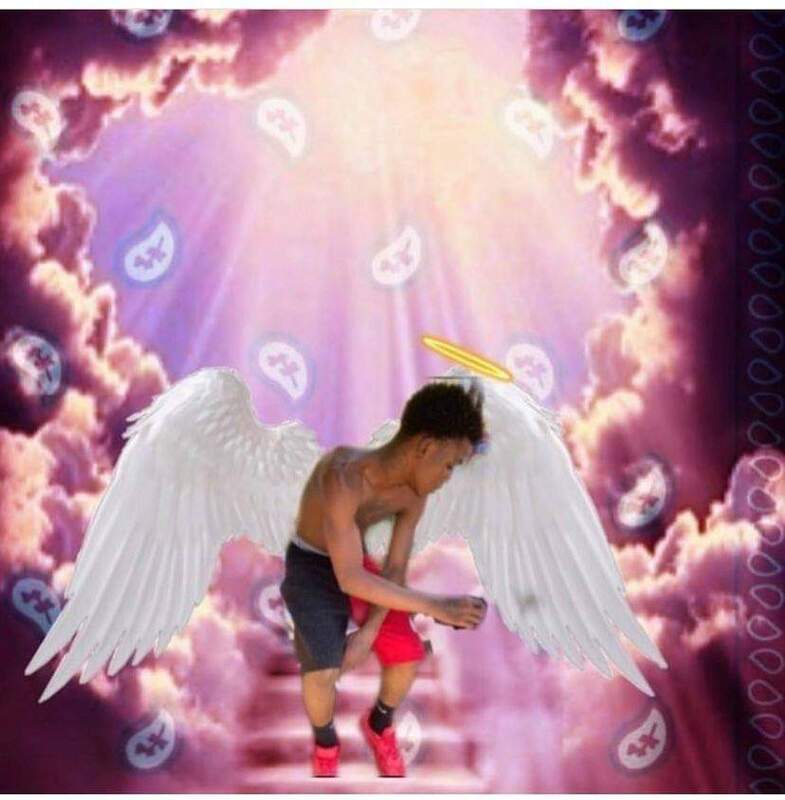
-0022-06-11
During this pandemic I was just getting adjusted to becoming a student again. I invested into some music equipment to provide my son and my nephew an outlet and something that could keep them occupied. The pandemic forced me to not be around my nephew and other family members. During September 2020 my nephew’s life was taken due to violence. This crushed my spirit and I felt like a failure. I lost two people I love ❤️during this pandemic my mother in January 2022 and my nephew. We were forced in isolation and could not spend quality time with each other.
-
2022-06-10
What’s it like living in lockdown?
Everyday felt like a cycle, especially online school.
You wake up:
-Turn your laptop on
-Eat
-Sleep
- Defecate
and repeat
No leisure activities on the weekends, like we used to have.
You're separated from socialisation, family, and friends.
So you start to try new hobbies. Or instead, rot in your hobbit hole (bedroom).
If I'm being real, I spent my lockdown in a big t-shirt and walking around in my underwear.
Skateparks were closed so I skated in my driveway and neighbourhood.
All my neighbours could hear was the slamming of my board, and ahhhh.
I eventually switched to skating in my garage, and then just stopped skating as a whole.
I tried writing screenplays, which were terrible.
Lockdown was separation from people to people contact, boredom, weight gain, and extremely long screen time.
I’m glad it’s over, but I definitely learned a little bit about myself.
The fact that everyone else was in lockdown made it a lot more doable.
-

2022-05-29
This biography was created out of a self-directed project from the HST580 class. This biography will be linked to the submissions of the person mentioned in the document and title.
-

2022-06-04
This is a news story from The Seattle Times by Scott Greenstone. Pride has changed quite a bit over the last two years due to COVID. For a while, Pride celebrations were held virtually. The in-person events in 2022 will now resemble what Pride was like prior to the virus. Included in this article are personal stories of people who did not come out until the pandemic, with this year being the first year they will attend Pride in-person.
For some, they didn't realize they were trans until the pandemic hit. Rhys Hutton, for instance, did not know he was trans, and is also coming to grips with having autism. Hutton's story of how he came to the realization started on TikTok when the algorithm kept showing videos of trans-masculine people. This exposure helped him figure out his identity more.
Stories like this are not uncommon, according to a recent Gallup poll, ten percent of Millennials and twenty percent of Gen Z identify as LGBTQ+.
-

2022-06-08
This is a news story from CNN by Jamie Gumbrecht. Moderna believes that their COVID-19 booster is effective against Ominicron, and more effective compared to the normal two doses. The claim is that the booster provided a stronger antibody response than the initial two doses.
-

2022-06-09
This is a news story from CNN by Donald Judd and Betsy Klein. The Biden administration has announced a vaccine rollout for children five and under. The vaccinations are to start as early as the week of June 20.
-

2022-06-06
This biography was created out of a self-directed project from the HST580 class. This biography will be linked to the submissions of the person mentioned in the document and title.
-

2022-06-06
This biography was created out of a self-directed project from the HST580 class. This biography will be linked to the submissions of the person mentioned in the document and title.
-
2022-06-01
I remember the days leading up to lock down, one of my professors was warning us that if need be we would effortlessly be able to transition the remaining weeks of class online. To my peers and I, we thought that was a little extreme to talk to us about going remote, we didn't think something that was happening in another continent would reach us so quickly. Fast forward a week or two, work was so slow we were ordering food and sitting around talking for the entirety of our shift. At the time I was a host and was getting paid hourly so I didn't mind but I didn't think about the way it was affecting our bartenders and servers. Within the next two days we were shutdown and I was filing for unemployment. Interestingly enough, that time was the most money I've ever made in my life. I was collecting 2-3x more money than I would have gotten if I was working. I changed my life style, I started nannying once August of 2022 came around because I couldn't afford to only have my hourly host pay once things started to open back up again. I was eventually given a promotion at work to Bartend once my nanny family no longer needed me since they were comfortable with the kids going back to school and day care. I was making a livable wage but it was nothing compared to what sales were before covid. It was never consistent, when the numbers began to spike people, reasonably so, would stay home and money was tight. I was so unhappy at my current job I was despiertly seeking a new one but in January of 2022, it was still a little scary, numbers were spiking and finding a new industry job seemed next to impossible. I found one but it came with a lot of consequences. I struggled financially for months. If it wasn't for the support of my family, I wasn't sure if I would have been able to make rent, pay my car, or even feed myself. Thankfully as the months have gone on it's gotten better. It's now June of 2022; over two years since the pandemic first started, and while nothing is normal, it's the closest it's ever been. Those who were once in the same position as me, scared of how they were going to survive are back to making livable wages. But I won't lie, I'm still scared, there is no certainty or promise that things will stay as "normal" as they are this 2022 summer. All we can do is hope and pray, and be thankful and grateful we're here to talk about it.
-
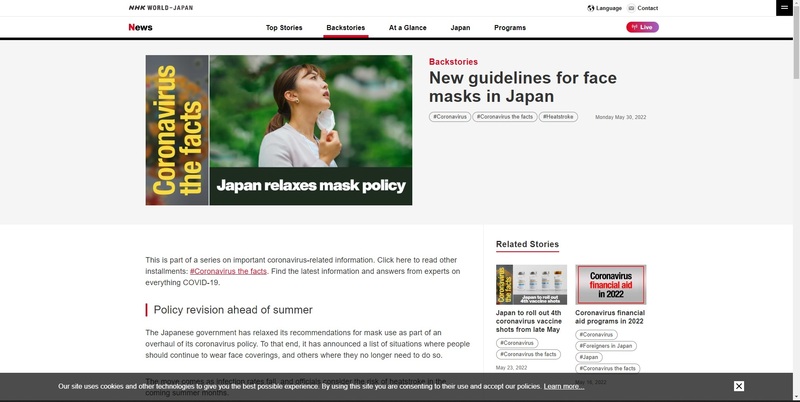
2022-05-30
Japan, as of May 30th, 2022, is relaxing the face mask guidelines. For the most part, masks do not need to be worn outdoors except when the elderly are in close quarters to other people. Indoors, masks are still required indoors except in the case of when someone is in little to no conversation, which the article shows in a chart. The chart's example states walking around museums and libraries where there is little to no conversation. One of the reasons for why Japan is relaxing face masks is because summer is approaching and the temperature will rise. There are fears about face masks causing heatstroke. In Japan, temperatures can range from 70-90 degrees F, but the summers are hot and humid too. So, it makes sense to relax the restrictions, especially in the outdoors.
-

2022-05-26
This biography was created out of a self-directed project from the HST580 class. This biography will be linked to the submissions of the person mentioned in the document and title.
-

2020-09-20
This assignment was given to students in Northeastern University's HIST 1219, History of Global Pandemics, taught by Dr. Streets-Salter in Fall 2020, and then taught by a graduate student in Fall 2021.
-

2020-12-04
This is an optional assignment given to students in Northeastern University HIST 1323, History of Boston, taught by Dr. Rabinovitch in Fall 2020.
-
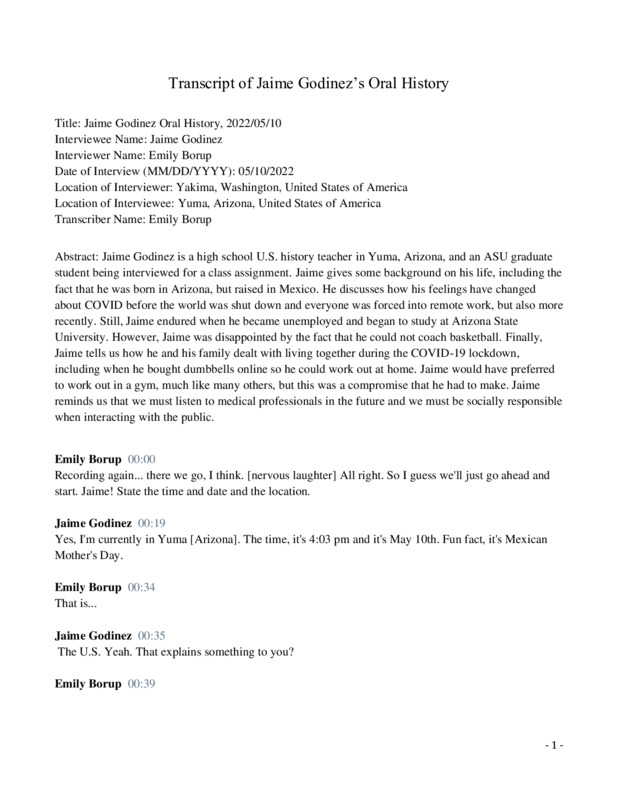
2022-05-10
Jaime Godinez is a high school U.S. history teacher in Yuma, Arizona, and an ASU graduate student being interviewed for a class assignment. Jaime gives some background on his life, including the fact that he was born in Arizona, but raised in Mexico. He discusses how his feelings have changed about COVID before the world was shut down and everyone was forced into remote work, but also more recently. Still, Jaime endured when he became unemployed and began to study at Arizona State University. However, Jaime was disappointed by the fact that he could not coach basketball. Finally, Jaime tells us how he and his family dealt with living together during the COVID-19 lockdown, including when he bought dumbbells online so he could work out at home. Jaime would have preferred to work out in a gym, much like many others, but this was a compromise that he had to make. Jaime reminds us that we must listen to medical professionals in the future and we must be socially responsible when interacting with the public.
 2022-05-02
2022-05-02 2022-06-25
2022-06-25 2022-06-15
2022-06-15 2022-06-23
2022-06-23 2022-06-22
2022-06-22 2022-06-22
2022-06-22 2022-06-17
2022-06-17 2022-06-18
2022-06-18 2022-06-16
2022-06-16 2022-06-15
2022-06-15 2022-06-16
2022-06-16 2022-06-17
2022-06-17 2022-06-17
2022-06-17 2022-06-17
2022-06-17 2022-06-16
2022-06-16 2022-06-16
2022-06-16 0031-03-22
0031-03-22 2022-02
2022-02 2022-02
2022-02 2022-06-14
2022-06-14 2022-06-14
2022-06-14 2022-06-14
2022-06-14 -2020-09-29
-2020-09-29 2022-06-13
2022-06-13 2022-06-10
2022-06-10 2022-06-09
2022-06-09 2022-06-11
2022-06-11 2022-06-11
2022-06-11 2022-06-09
2022-06-09 2022-06-10
2022-06-10 2022-06-10
2022-06-10 2022-06-09
2022-06-09 2022-06-11
2022-06-11 2022-06-10
2022-06-10 -0022-06-11
-0022-06-11 2022-05-29
2022-05-29 2022-06-04
2022-06-04 2022-06-08
2022-06-08 2022-06-09
2022-06-09 2022-06-06
2022-06-06 2022-06-06
2022-06-06 2022-05-30
2022-05-30 2022-05-26
2022-05-26 2020-09-20
2020-09-20 2020-12-04
2020-12-04 2022-05-10
2022-05-10